BUS5SMM - Analyzing Sustainable Marketing and Supply Chain Alignment
VerifiedAdded on 2023/06/15
|12
|2391
|435
Report
AI Summary
This report examines the alignment between marketing and supply chain processes for sustainable marketing management, focusing on the article "Aligning the sustainable supply chain to green marketing needs: A case study." Key points from the article are extracted and compared with other research, revealing the necessity of aligning marketing and supply chain for organizational success. The report discusses challenges in aligning green marketing with supply chain procurement, differences in organizational perspectives on sustainability, the importance of reverse information flow, and the need for better synchronization between supply chain and marketing management. It concludes by emphasizing the need for stability in supply and market positioning for sustainable business practices. Desklib provides access to similar solved assignments and past papers.
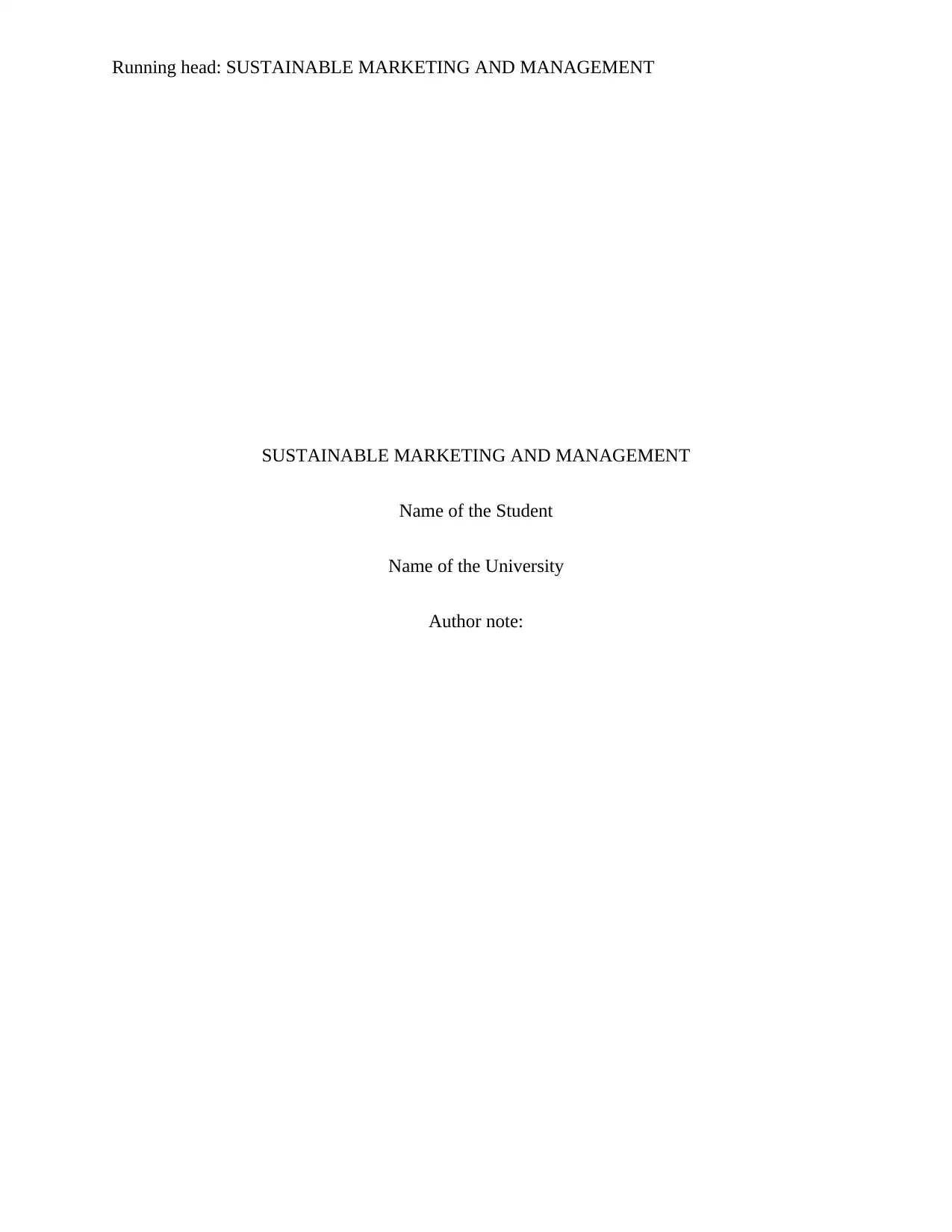
Running head: SUSTAINABLE MARKETING AND MANAGEMENT
SUSTAINABLE MARKETING AND MANAGEMENT
Name of the Student
Name of the University
Author note:
SUSTAINABLE MARKETING AND MANAGEMENT
Name of the Student
Name of the University
Author note:
Paraphrase This Document
Need a fresh take? Get an instant paraphrase of this document with our AI Paraphraser
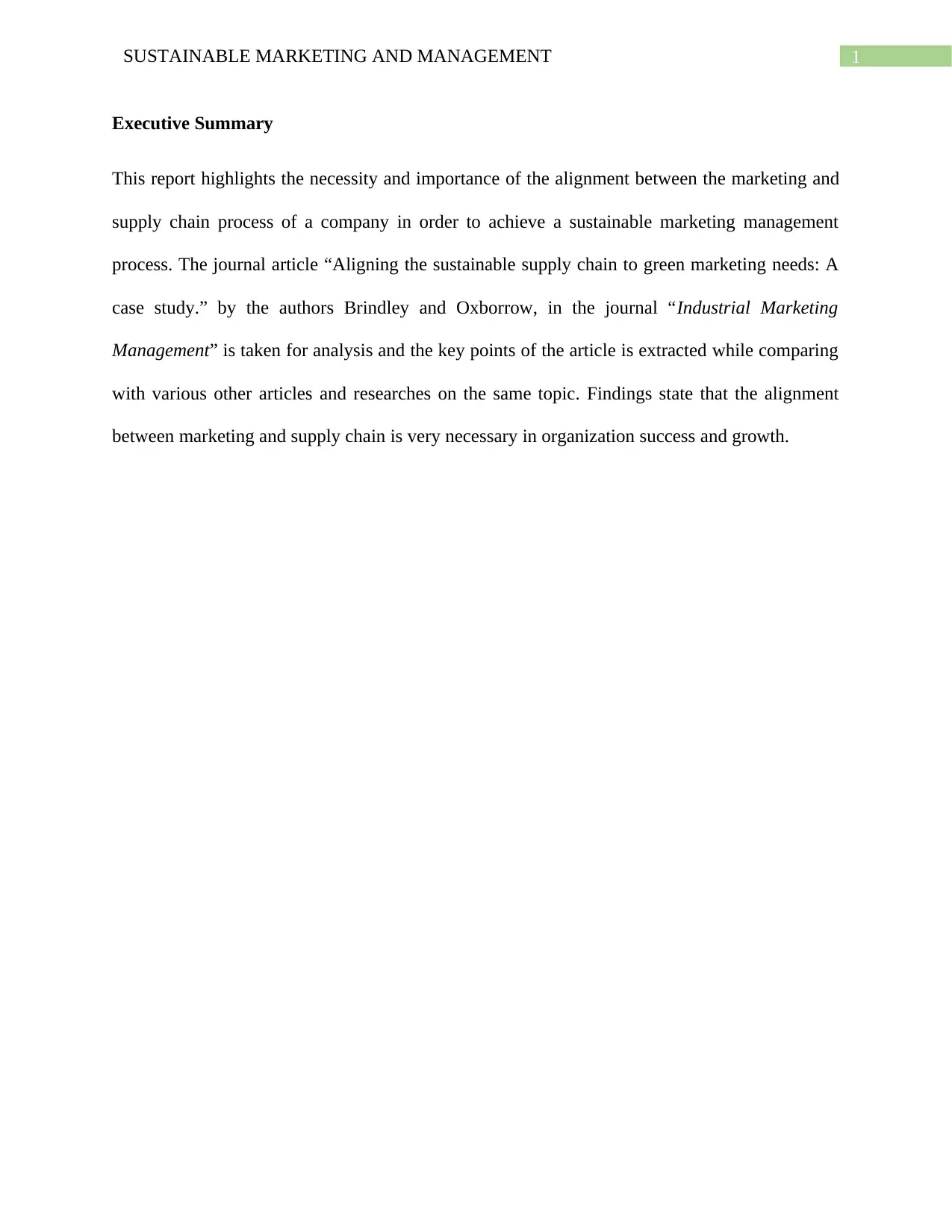
1SUSTAINABLE MARKETING AND MANAGEMENT
Executive Summary
This report highlights the necessity and importance of the alignment between the marketing and
supply chain process of a company in order to achieve a sustainable marketing management
process. The journal article “Aligning the sustainable supply chain to green marketing needs: A
case study.” by the authors Brindley and Oxborrow, in the journal “Industrial Marketing
Management” is taken for analysis and the key points of the article is extracted while comparing
with various other articles and researches on the same topic. Findings state that the alignment
between marketing and supply chain is very necessary in organization success and growth.
Executive Summary
This report highlights the necessity and importance of the alignment between the marketing and
supply chain process of a company in order to achieve a sustainable marketing management
process. The journal article “Aligning the sustainable supply chain to green marketing needs: A
case study.” by the authors Brindley and Oxborrow, in the journal “Industrial Marketing
Management” is taken for analysis and the key points of the article is extracted while comparing
with various other articles and researches on the same topic. Findings state that the alignment
between marketing and supply chain is very necessary in organization success and growth.
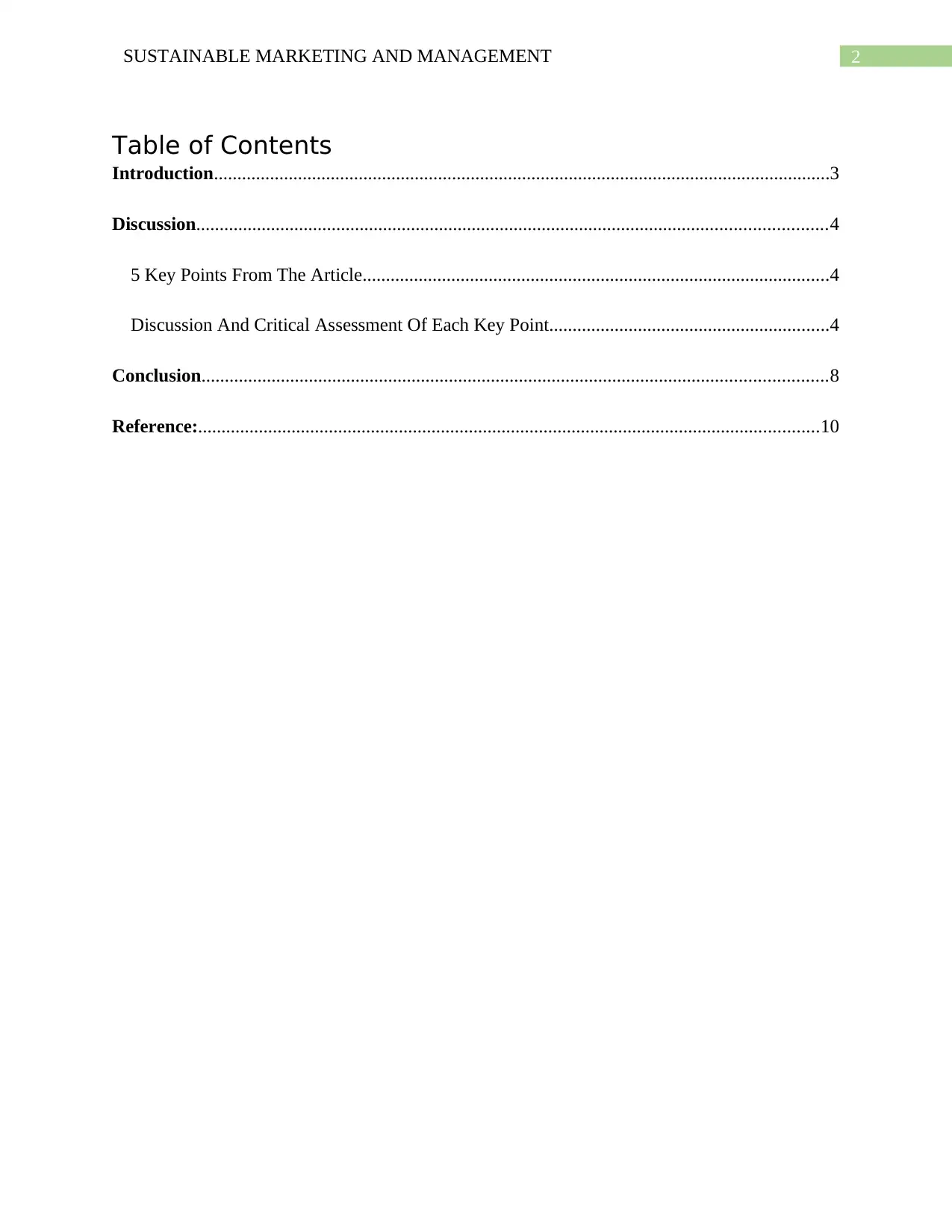
2SUSTAINABLE MARKETING AND MANAGEMENT
Table of Contents
Introduction....................................................................................................................................3
Discussion.......................................................................................................................................4
5 Key Points From The Article....................................................................................................4
Discussion And Critical Assessment Of Each Key Point............................................................4
Conclusion......................................................................................................................................8
Reference:.....................................................................................................................................10
Table of Contents
Introduction....................................................................................................................................3
Discussion.......................................................................................................................................4
5 Key Points From The Article....................................................................................................4
Discussion And Critical Assessment Of Each Key Point............................................................4
Conclusion......................................................................................................................................8
Reference:.....................................................................................................................................10
⊘ This is a preview!⊘
Do you want full access?
Subscribe today to unlock all pages.

Trusted by 1+ million students worldwide
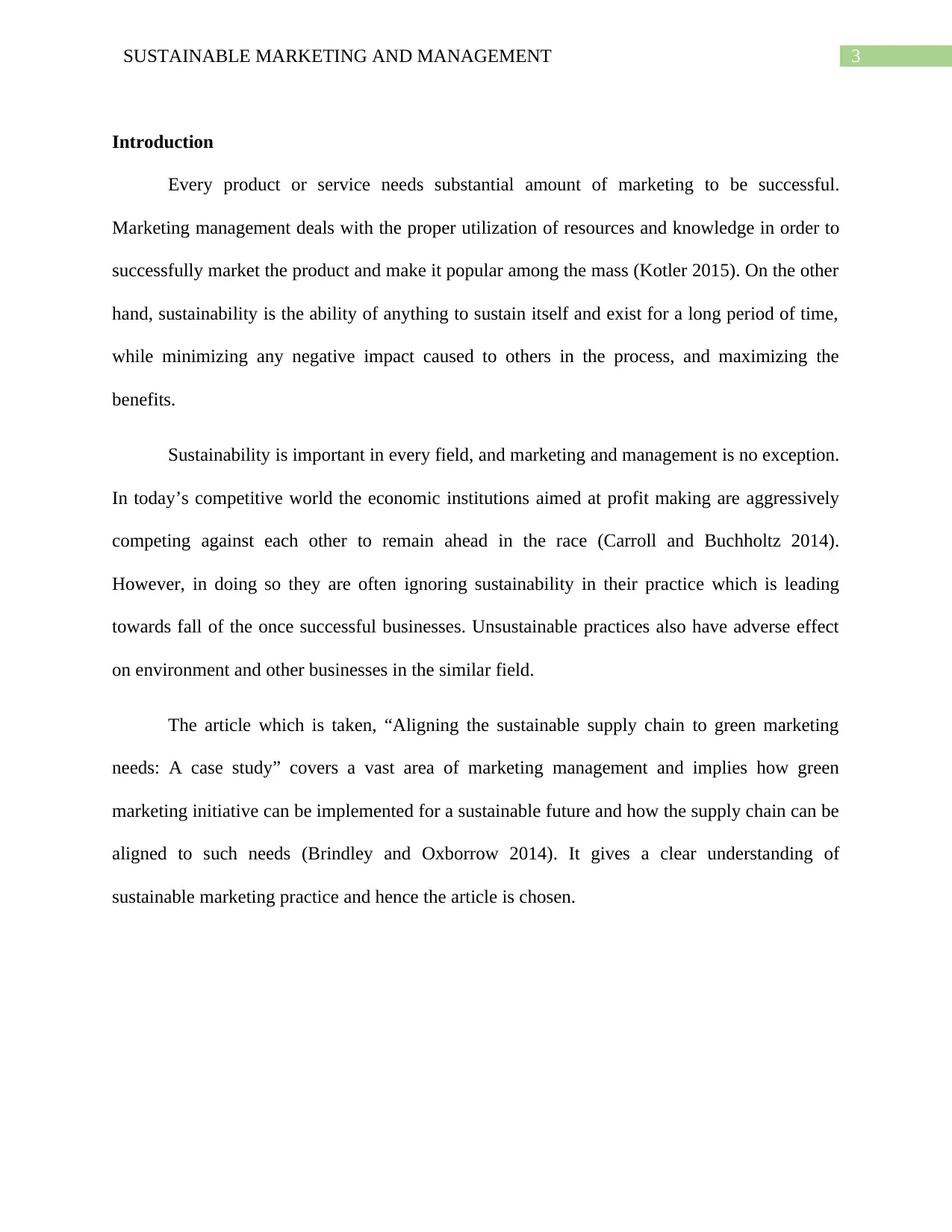
3SUSTAINABLE MARKETING AND MANAGEMENT
Introduction
Every product or service needs substantial amount of marketing to be successful.
Marketing management deals with the proper utilization of resources and knowledge in order to
successfully market the product and make it popular among the mass (Kotler 2015). On the other
hand, sustainability is the ability of anything to sustain itself and exist for a long period of time,
while minimizing any negative impact caused to others in the process, and maximizing the
benefits.
Sustainability is important in every field, and marketing and management is no exception.
In today’s competitive world the economic institutions aimed at profit making are aggressively
competing against each other to remain ahead in the race (Carroll and Buchholtz 2014).
However, in doing so they are often ignoring sustainability in their practice which is leading
towards fall of the once successful businesses. Unsustainable practices also have adverse effect
on environment and other businesses in the similar field.
The article which is taken, “Aligning the sustainable supply chain to green marketing
needs: A case study” covers a vast area of marketing management and implies how green
marketing initiative can be implemented for a sustainable future and how the supply chain can be
aligned to such needs (Brindley and Oxborrow 2014). It gives a clear understanding of
sustainable marketing practice and hence the article is chosen.
Introduction
Every product or service needs substantial amount of marketing to be successful.
Marketing management deals with the proper utilization of resources and knowledge in order to
successfully market the product and make it popular among the mass (Kotler 2015). On the other
hand, sustainability is the ability of anything to sustain itself and exist for a long period of time,
while minimizing any negative impact caused to others in the process, and maximizing the
benefits.
Sustainability is important in every field, and marketing and management is no exception.
In today’s competitive world the economic institutions aimed at profit making are aggressively
competing against each other to remain ahead in the race (Carroll and Buchholtz 2014).
However, in doing so they are often ignoring sustainability in their practice which is leading
towards fall of the once successful businesses. Unsustainable practices also have adverse effect
on environment and other businesses in the similar field.
The article which is taken, “Aligning the sustainable supply chain to green marketing
needs: A case study” covers a vast area of marketing management and implies how green
marketing initiative can be implemented for a sustainable future and how the supply chain can be
aligned to such needs (Brindley and Oxborrow 2014). It gives a clear understanding of
sustainable marketing practice and hence the article is chosen.
Paraphrase This Document
Need a fresh take? Get an instant paraphrase of this document with our AI Paraphraser
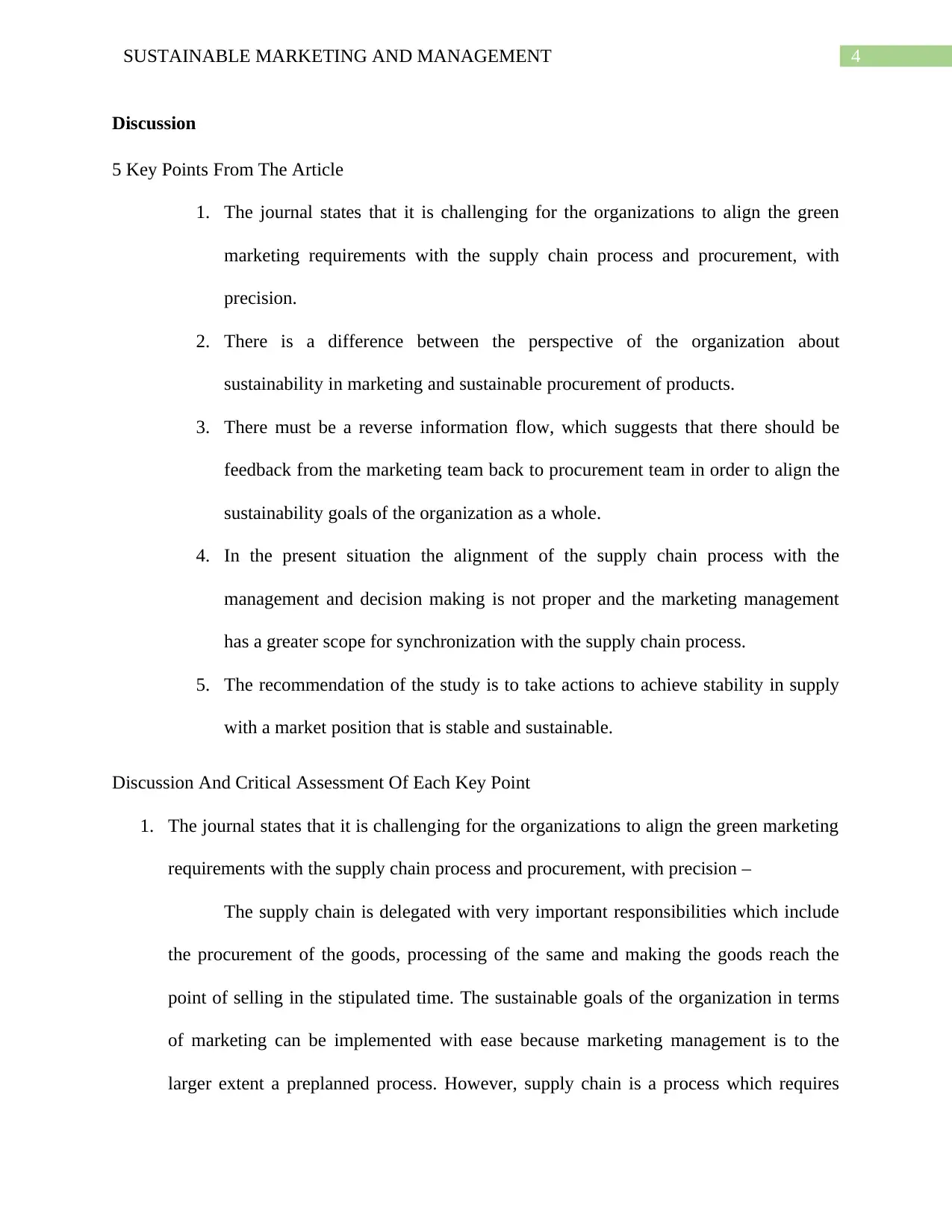
4SUSTAINABLE MARKETING AND MANAGEMENT
Discussion
5 Key Points From The Article
1. The journal states that it is challenging for the organizations to align the green
marketing requirements with the supply chain process and procurement, with
precision.
2. There is a difference between the perspective of the organization about
sustainability in marketing and sustainable procurement of products.
3. There must be a reverse information flow, which suggests that there should be
feedback from the marketing team back to procurement team in order to align the
sustainability goals of the organization as a whole.
4. In the present situation the alignment of the supply chain process with the
management and decision making is not proper and the marketing management
has a greater scope for synchronization with the supply chain process.
5. The recommendation of the study is to take actions to achieve stability in supply
with a market position that is stable and sustainable.
Discussion And Critical Assessment Of Each Key Point
1. The journal states that it is challenging for the organizations to align the green marketing
requirements with the supply chain process and procurement, with precision –
The supply chain is delegated with very important responsibilities which include
the procurement of the goods, processing of the same and making the goods reach the
point of selling in the stipulated time. The sustainable goals of the organization in terms
of marketing can be implemented with ease because marketing management is to the
larger extent a preplanned process. However, supply chain is a process which requires
Discussion
5 Key Points From The Article
1. The journal states that it is challenging for the organizations to align the green
marketing requirements with the supply chain process and procurement, with
precision.
2. There is a difference between the perspective of the organization about
sustainability in marketing and sustainable procurement of products.
3. There must be a reverse information flow, which suggests that there should be
feedback from the marketing team back to procurement team in order to align the
sustainability goals of the organization as a whole.
4. In the present situation the alignment of the supply chain process with the
management and decision making is not proper and the marketing management
has a greater scope for synchronization with the supply chain process.
5. The recommendation of the study is to take actions to achieve stability in supply
with a market position that is stable and sustainable.
Discussion And Critical Assessment Of Each Key Point
1. The journal states that it is challenging for the organizations to align the green marketing
requirements with the supply chain process and procurement, with precision –
The supply chain is delegated with very important responsibilities which include
the procurement of the goods, processing of the same and making the goods reach the
point of selling in the stipulated time. The sustainable goals of the organization in terms
of marketing can be implemented with ease because marketing management is to the
larger extent a preplanned process. However, supply chain is a process which requires
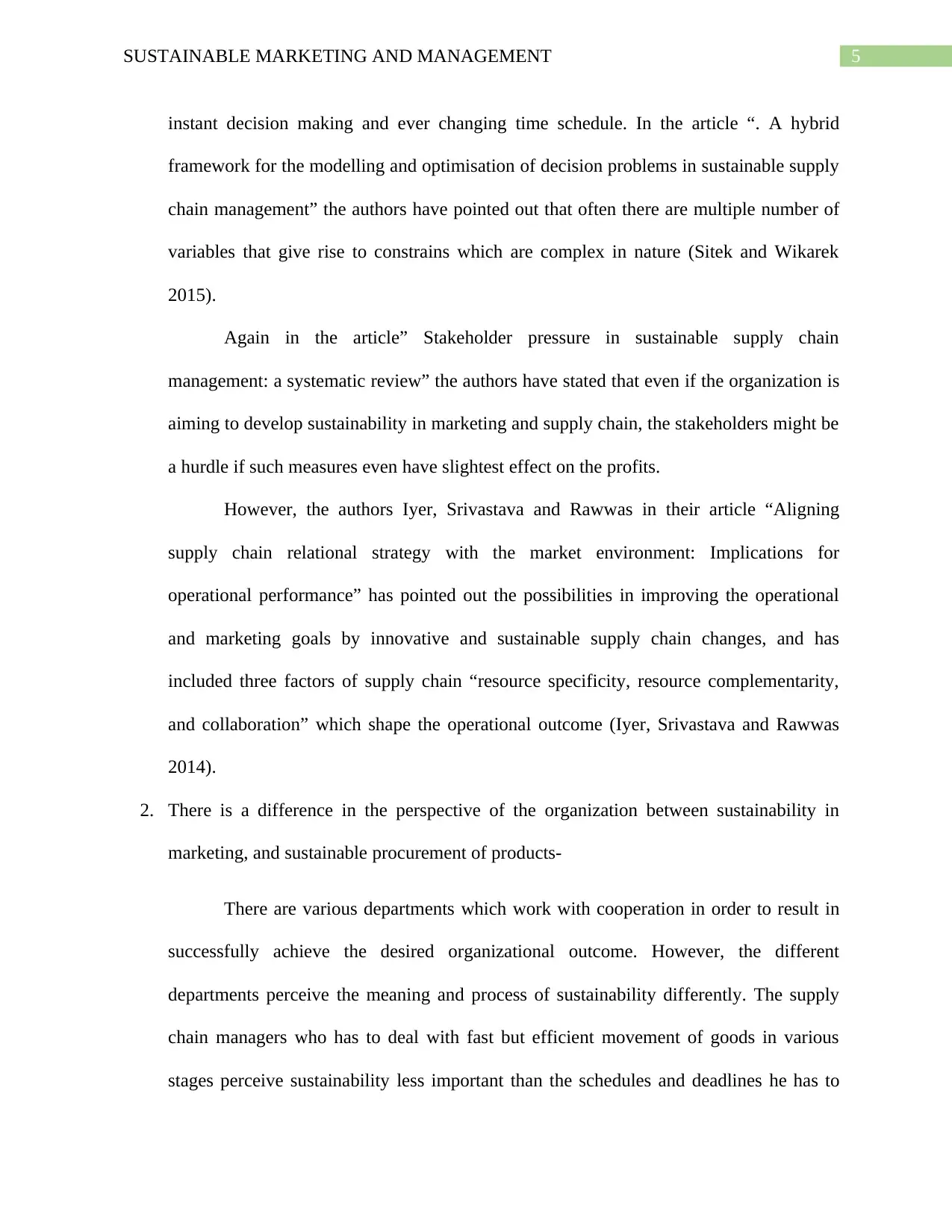
5SUSTAINABLE MARKETING AND MANAGEMENT
instant decision making and ever changing time schedule. In the article “. A hybrid
framework for the modelling and optimisation of decision problems in sustainable supply
chain management” the authors have pointed out that often there are multiple number of
variables that give rise to constrains which are complex in nature (Sitek and Wikarek
2015).
Again in the article” Stakeholder pressure in sustainable supply chain
management: a systematic review” the authors have stated that even if the organization is
aiming to develop sustainability in marketing and supply chain, the stakeholders might be
a hurdle if such measures even have slightest effect on the profits.
However, the authors Iyer, Srivastava and Rawwas in their article “Aligning
supply chain relational strategy with the market environment: Implications for
operational performance” has pointed out the possibilities in improving the operational
and marketing goals by innovative and sustainable supply chain changes, and has
included three factors of supply chain “resource specificity, resource complementarity,
and collaboration” which shape the operational outcome (Iyer, Srivastava and Rawwas
2014).
2. There is a difference in the perspective of the organization between sustainability in
marketing, and sustainable procurement of products-
There are various departments which work with cooperation in order to result in
successfully achieve the desired organizational outcome. However, the different
departments perceive the meaning and process of sustainability differently. The supply
chain managers who has to deal with fast but efficient movement of goods in various
stages perceive sustainability less important than the schedules and deadlines he has to
instant decision making and ever changing time schedule. In the article “. A hybrid
framework for the modelling and optimisation of decision problems in sustainable supply
chain management” the authors have pointed out that often there are multiple number of
variables that give rise to constrains which are complex in nature (Sitek and Wikarek
2015).
Again in the article” Stakeholder pressure in sustainable supply chain
management: a systematic review” the authors have stated that even if the organization is
aiming to develop sustainability in marketing and supply chain, the stakeholders might be
a hurdle if such measures even have slightest effect on the profits.
However, the authors Iyer, Srivastava and Rawwas in their article “Aligning
supply chain relational strategy with the market environment: Implications for
operational performance” has pointed out the possibilities in improving the operational
and marketing goals by innovative and sustainable supply chain changes, and has
included three factors of supply chain “resource specificity, resource complementarity,
and collaboration” which shape the operational outcome (Iyer, Srivastava and Rawwas
2014).
2. There is a difference in the perspective of the organization between sustainability in
marketing, and sustainable procurement of products-
There are various departments which work with cooperation in order to result in
successfully achieve the desired organizational outcome. However, the different
departments perceive the meaning and process of sustainability differently. The supply
chain managers who has to deal with fast but efficient movement of goods in various
stages perceive sustainability less important than the schedules and deadlines he has to
⊘ This is a preview!⊘
Do you want full access?
Subscribe today to unlock all pages.

Trusted by 1+ million students worldwide
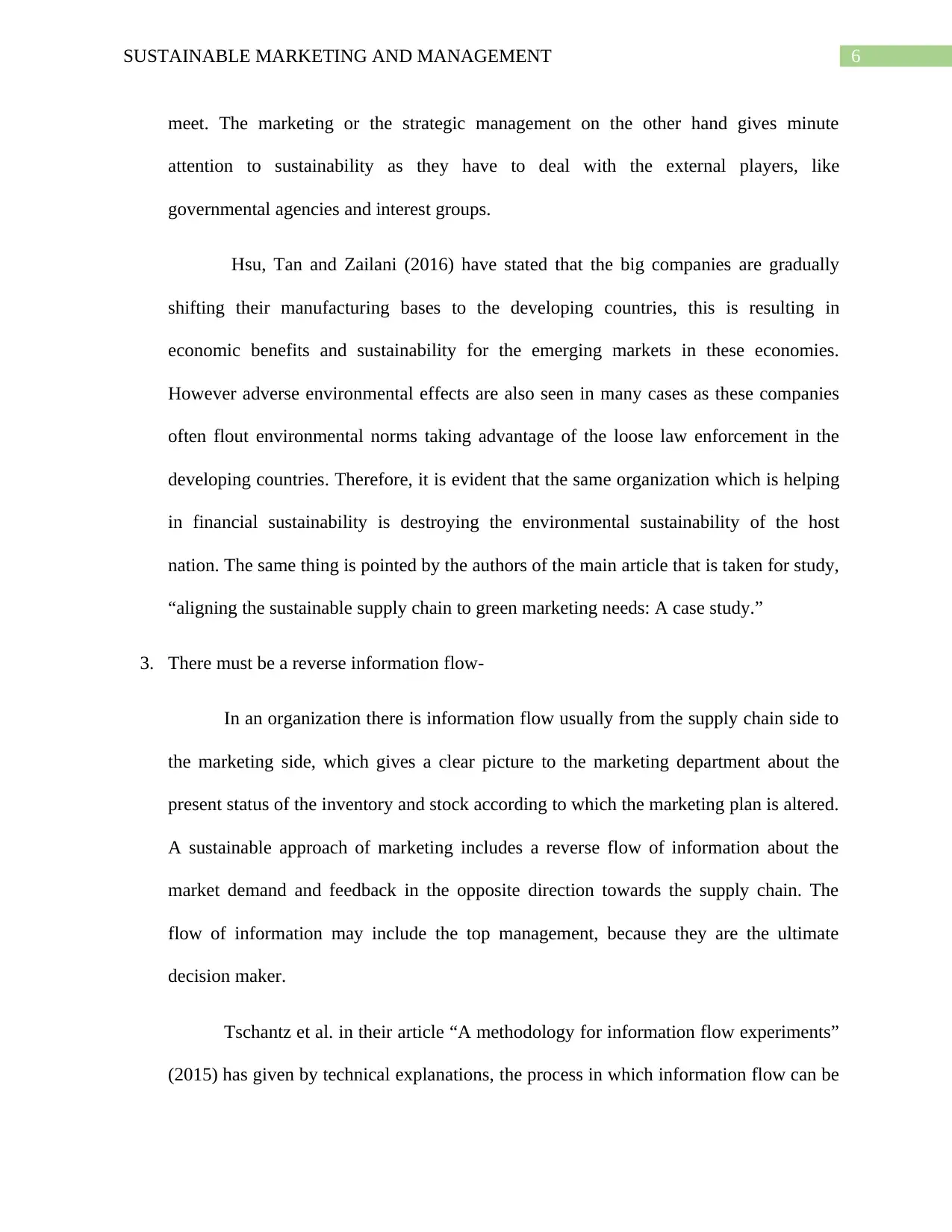
6SUSTAINABLE MARKETING AND MANAGEMENT
meet. The marketing or the strategic management on the other hand gives minute
attention to sustainability as they have to deal with the external players, like
governmental agencies and interest groups.
Hsu, Tan and Zailani (2016) have stated that the big companies are gradually
shifting their manufacturing bases to the developing countries, this is resulting in
economic benefits and sustainability for the emerging markets in these economies.
However adverse environmental effects are also seen in many cases as these companies
often flout environmental norms taking advantage of the loose law enforcement in the
developing countries. Therefore, it is evident that the same organization which is helping
in financial sustainability is destroying the environmental sustainability of the host
nation. The same thing is pointed by the authors of the main article that is taken for study,
“aligning the sustainable supply chain to green marketing needs: A case study.”
3. There must be a reverse information flow-
In an organization there is information flow usually from the supply chain side to
the marketing side, which gives a clear picture to the marketing department about the
present status of the inventory and stock according to which the marketing plan is altered.
A sustainable approach of marketing includes a reverse flow of information about the
market demand and feedback in the opposite direction towards the supply chain. The
flow of information may include the top management, because they are the ultimate
decision maker.
Tschantz et al. in their article “A methodology for information flow experiments”
(2015) has given by technical explanations, the process in which information flow can be
meet. The marketing or the strategic management on the other hand gives minute
attention to sustainability as they have to deal with the external players, like
governmental agencies and interest groups.
Hsu, Tan and Zailani (2016) have stated that the big companies are gradually
shifting their manufacturing bases to the developing countries, this is resulting in
economic benefits and sustainability for the emerging markets in these economies.
However adverse environmental effects are also seen in many cases as these companies
often flout environmental norms taking advantage of the loose law enforcement in the
developing countries. Therefore, it is evident that the same organization which is helping
in financial sustainability is destroying the environmental sustainability of the host
nation. The same thing is pointed by the authors of the main article that is taken for study,
“aligning the sustainable supply chain to green marketing needs: A case study.”
3. There must be a reverse information flow-
In an organization there is information flow usually from the supply chain side to
the marketing side, which gives a clear picture to the marketing department about the
present status of the inventory and stock according to which the marketing plan is altered.
A sustainable approach of marketing includes a reverse flow of information about the
market demand and feedback in the opposite direction towards the supply chain. The
flow of information may include the top management, because they are the ultimate
decision maker.
Tschantz et al. in their article “A methodology for information flow experiments”
(2015) has given by technical explanations, the process in which information flow can be
Paraphrase This Document
Need a fresh take? Get an instant paraphrase of this document with our AI Paraphraser
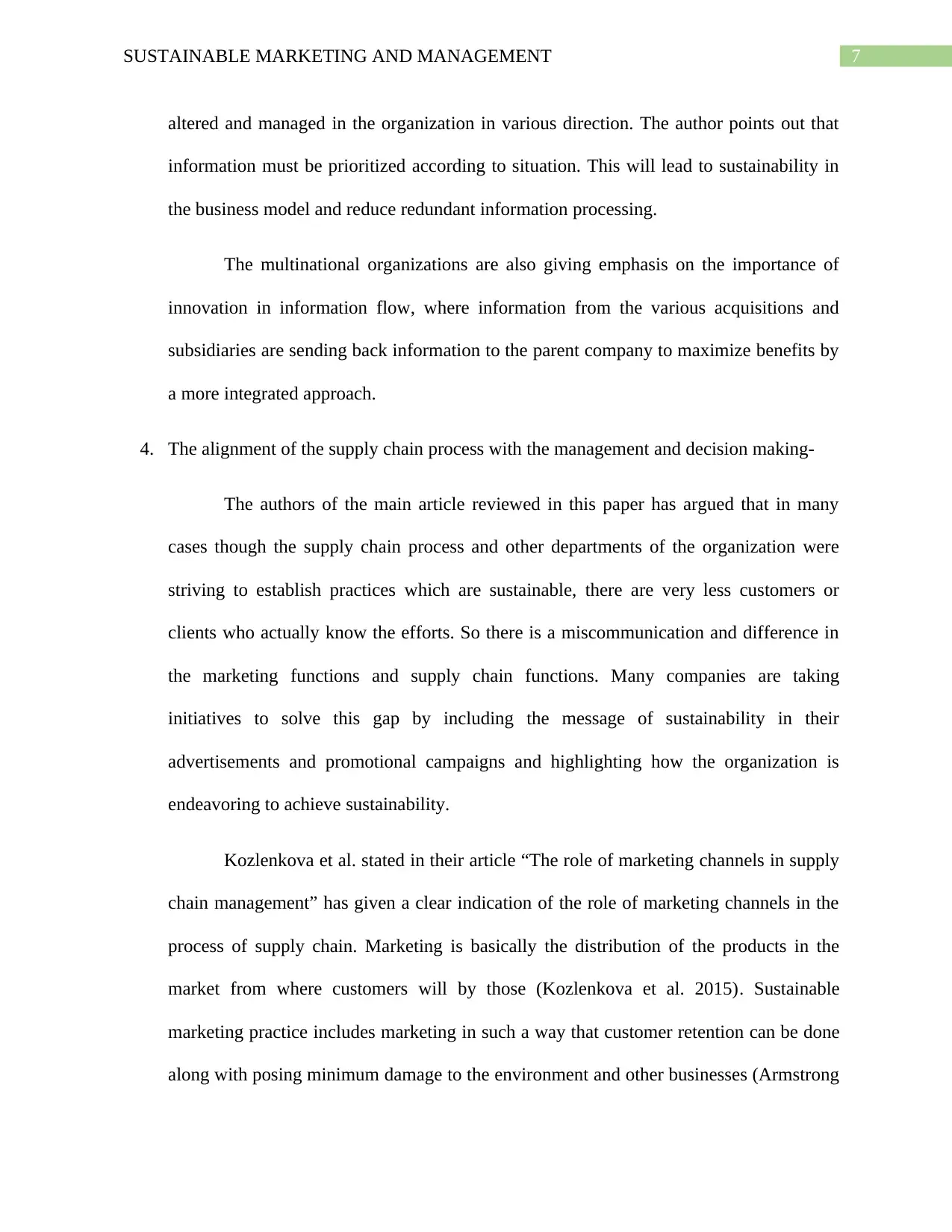
7SUSTAINABLE MARKETING AND MANAGEMENT
altered and managed in the organization in various direction. The author points out that
information must be prioritized according to situation. This will lead to sustainability in
the business model and reduce redundant information processing.
The multinational organizations are also giving emphasis on the importance of
innovation in information flow, where information from the various acquisitions and
subsidiaries are sending back information to the parent company to maximize benefits by
a more integrated approach.
4. The alignment of the supply chain process with the management and decision making-
The authors of the main article reviewed in this paper has argued that in many
cases though the supply chain process and other departments of the organization were
striving to establish practices which are sustainable, there are very less customers or
clients who actually know the efforts. So there is a miscommunication and difference in
the marketing functions and supply chain functions. Many companies are taking
initiatives to solve this gap by including the message of sustainability in their
advertisements and promotional campaigns and highlighting how the organization is
endeavoring to achieve sustainability.
Kozlenkova et al. stated in their article “The role of marketing channels in supply
chain management” has given a clear indication of the role of marketing channels in the
process of supply chain. Marketing is basically the distribution of the products in the
market from where customers will by those (Kozlenkova et al. 2015). Sustainable
marketing practice includes marketing in such a way that customer retention can be done
along with posing minimum damage to the environment and other businesses (Armstrong
altered and managed in the organization in various direction. The author points out that
information must be prioritized according to situation. This will lead to sustainability in
the business model and reduce redundant information processing.
The multinational organizations are also giving emphasis on the importance of
innovation in information flow, where information from the various acquisitions and
subsidiaries are sending back information to the parent company to maximize benefits by
a more integrated approach.
4. The alignment of the supply chain process with the management and decision making-
The authors of the main article reviewed in this paper has argued that in many
cases though the supply chain process and other departments of the organization were
striving to establish practices which are sustainable, there are very less customers or
clients who actually know the efforts. So there is a miscommunication and difference in
the marketing functions and supply chain functions. Many companies are taking
initiatives to solve this gap by including the message of sustainability in their
advertisements and promotional campaigns and highlighting how the organization is
endeavoring to achieve sustainability.
Kozlenkova et al. stated in their article “The role of marketing channels in supply
chain management” has given a clear indication of the role of marketing channels in the
process of supply chain. Marketing is basically the distribution of the products in the
market from where customers will by those (Kozlenkova et al. 2015). Sustainable
marketing practice includes marketing in such a way that customer retention can be done
along with posing minimum damage to the environment and other businesses (Armstrong
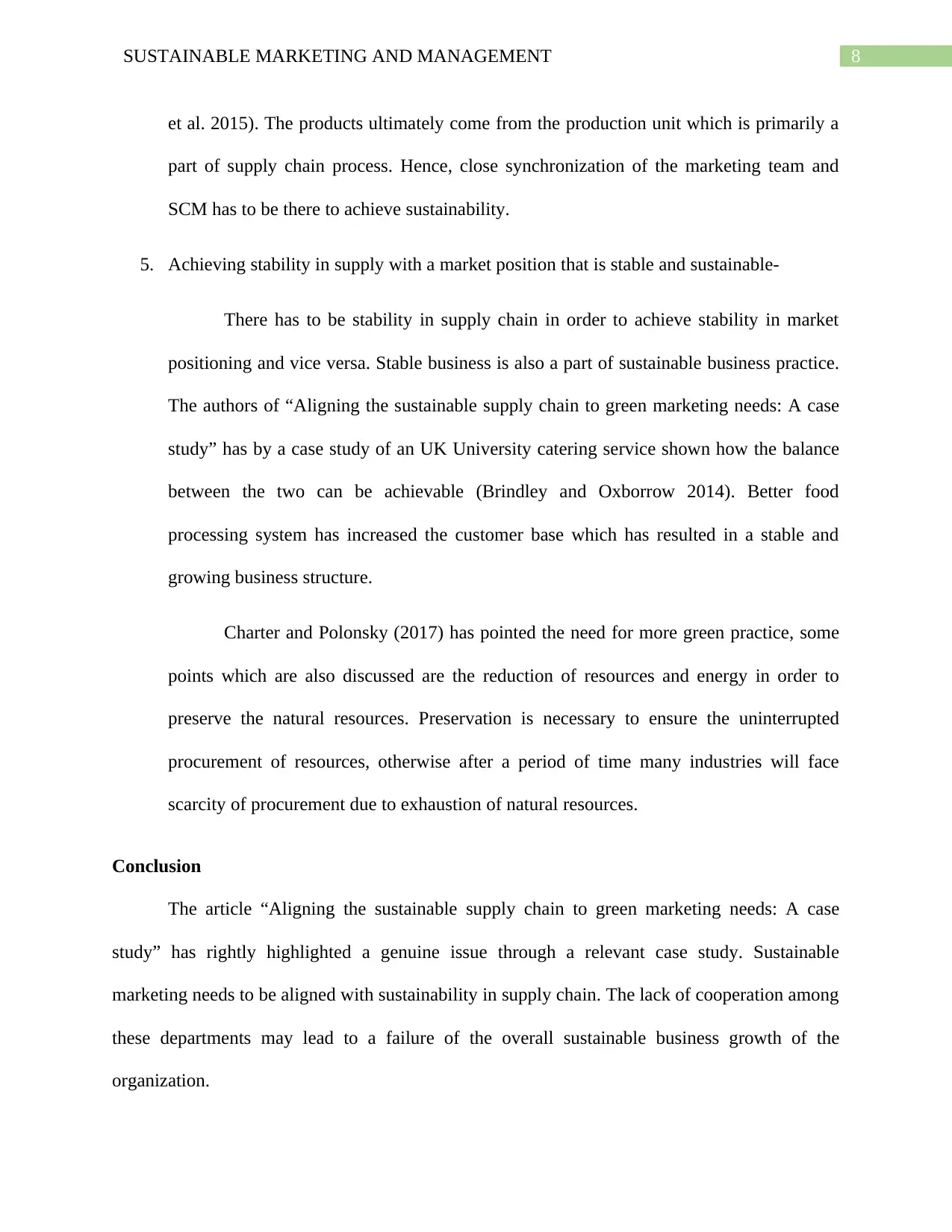
8SUSTAINABLE MARKETING AND MANAGEMENT
et al. 2015). The products ultimately come from the production unit which is primarily a
part of supply chain process. Hence, close synchronization of the marketing team and
SCM has to be there to achieve sustainability.
5. Achieving stability in supply with a market position that is stable and sustainable-
There has to be stability in supply chain in order to achieve stability in market
positioning and vice versa. Stable business is also a part of sustainable business practice.
The authors of “Aligning the sustainable supply chain to green marketing needs: A case
study” has by a case study of an UK University catering service shown how the balance
between the two can be achievable (Brindley and Oxborrow 2014). Better food
processing system has increased the customer base which has resulted in a stable and
growing business structure.
Charter and Polonsky (2017) has pointed the need for more green practice, some
points which are also discussed are the reduction of resources and energy in order to
preserve the natural resources. Preservation is necessary to ensure the uninterrupted
procurement of resources, otherwise after a period of time many industries will face
scarcity of procurement due to exhaustion of natural resources.
Conclusion
The article “Aligning the sustainable supply chain to green marketing needs: A case
study” has rightly highlighted a genuine issue through a relevant case study. Sustainable
marketing needs to be aligned with sustainability in supply chain. The lack of cooperation among
these departments may lead to a failure of the overall sustainable business growth of the
organization.
et al. 2015). The products ultimately come from the production unit which is primarily a
part of supply chain process. Hence, close synchronization of the marketing team and
SCM has to be there to achieve sustainability.
5. Achieving stability in supply with a market position that is stable and sustainable-
There has to be stability in supply chain in order to achieve stability in market
positioning and vice versa. Stable business is also a part of sustainable business practice.
The authors of “Aligning the sustainable supply chain to green marketing needs: A case
study” has by a case study of an UK University catering service shown how the balance
between the two can be achievable (Brindley and Oxborrow 2014). Better food
processing system has increased the customer base which has resulted in a stable and
growing business structure.
Charter and Polonsky (2017) has pointed the need for more green practice, some
points which are also discussed are the reduction of resources and energy in order to
preserve the natural resources. Preservation is necessary to ensure the uninterrupted
procurement of resources, otherwise after a period of time many industries will face
scarcity of procurement due to exhaustion of natural resources.
Conclusion
The article “Aligning the sustainable supply chain to green marketing needs: A case
study” has rightly highlighted a genuine issue through a relevant case study. Sustainable
marketing needs to be aligned with sustainability in supply chain. The lack of cooperation among
these departments may lead to a failure of the overall sustainable business growth of the
organization.
⊘ This is a preview!⊘
Do you want full access?
Subscribe today to unlock all pages.

Trusted by 1+ million students worldwide
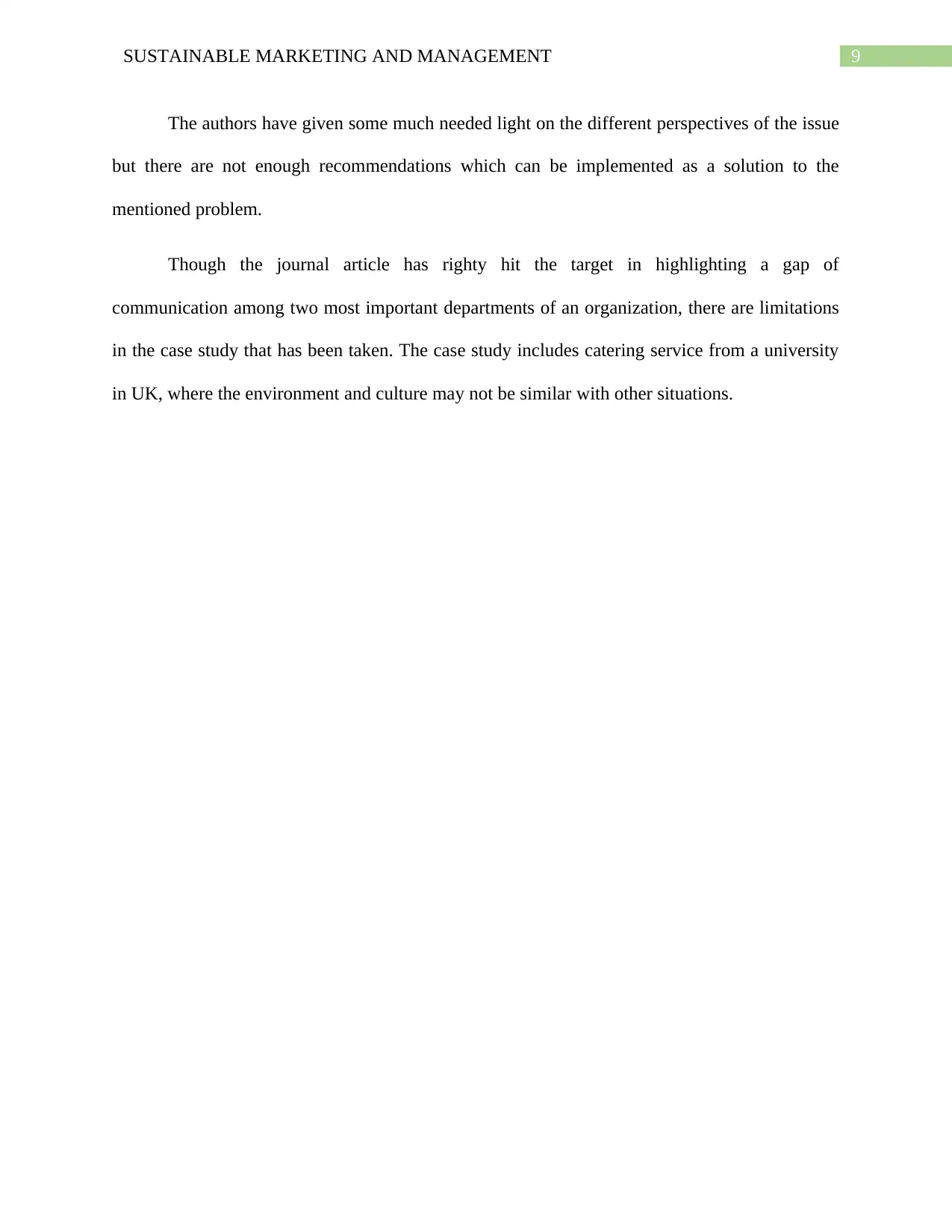
9SUSTAINABLE MARKETING AND MANAGEMENT
The authors have given some much needed light on the different perspectives of the issue
but there are not enough recommendations which can be implemented as a solution to the
mentioned problem.
Though the journal article has righty hit the target in highlighting a gap of
communication among two most important departments of an organization, there are limitations
in the case study that has been taken. The case study includes catering service from a university
in UK, where the environment and culture may not be similar with other situations.
The authors have given some much needed light on the different perspectives of the issue
but there are not enough recommendations which can be implemented as a solution to the
mentioned problem.
Though the journal article has righty hit the target in highlighting a gap of
communication among two most important departments of an organization, there are limitations
in the case study that has been taken. The case study includes catering service from a university
in UK, where the environment and culture may not be similar with other situations.
Paraphrase This Document
Need a fresh take? Get an instant paraphrase of this document with our AI Paraphraser
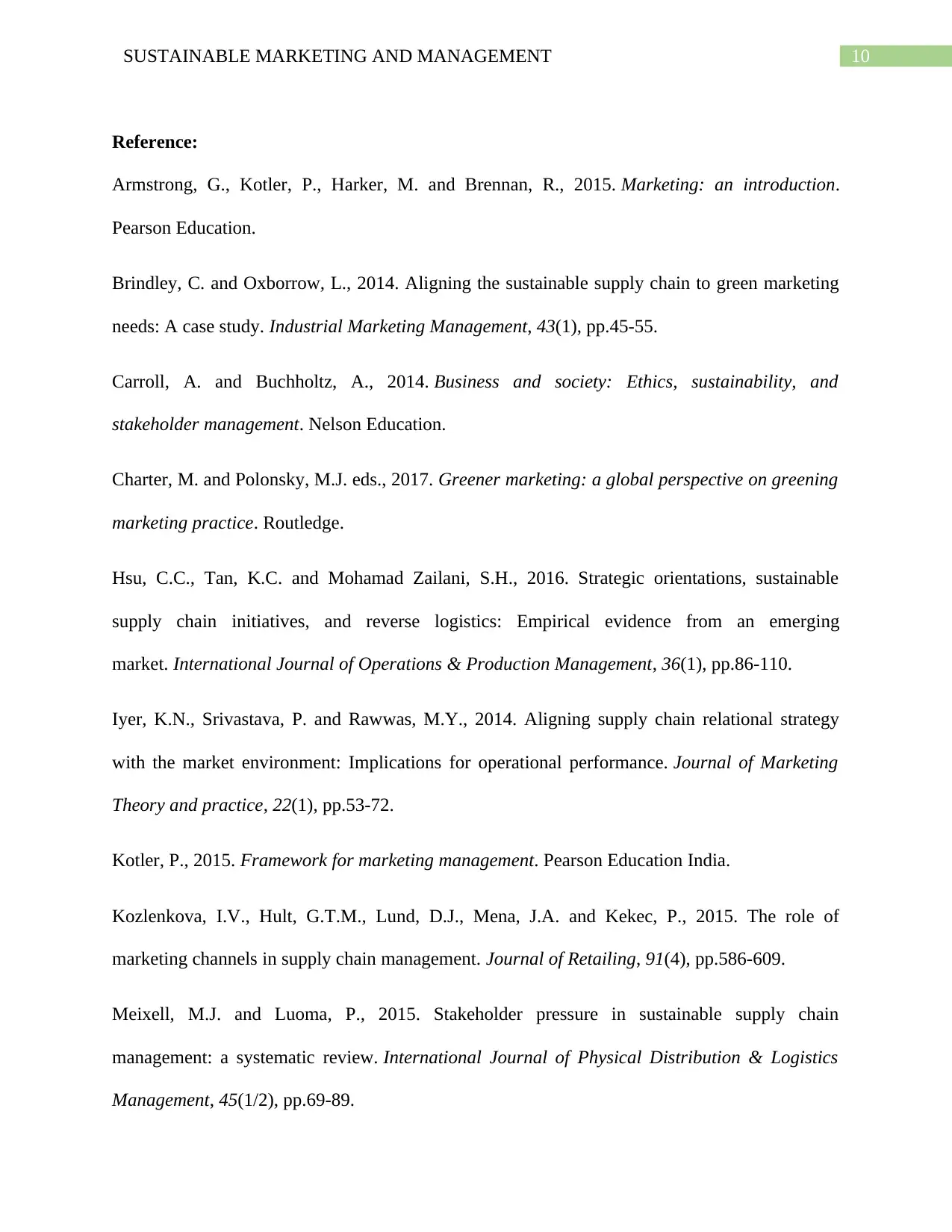
10SUSTAINABLE MARKETING AND MANAGEMENT
Reference:
Armstrong, G., Kotler, P., Harker, M. and Brennan, R., 2015. Marketing: an introduction.
Pearson Education.
Brindley, C. and Oxborrow, L., 2014. Aligning the sustainable supply chain to green marketing
needs: A case study. Industrial Marketing Management, 43(1), pp.45-55.
Carroll, A. and Buchholtz, A., 2014. Business and society: Ethics, sustainability, and
stakeholder management. Nelson Education.
Charter, M. and Polonsky, M.J. eds., 2017. Greener marketing: a global perspective on greening
marketing practice. Routledge.
Hsu, C.C., Tan, K.C. and Mohamad Zailani, S.H., 2016. Strategic orientations, sustainable
supply chain initiatives, and reverse logistics: Empirical evidence from an emerging
market. International Journal of Operations & Production Management, 36(1), pp.86-110.
Iyer, K.N., Srivastava, P. and Rawwas, M.Y., 2014. Aligning supply chain relational strategy
with the market environment: Implications for operational performance. Journal of Marketing
Theory and practice, 22(1), pp.53-72.
Kotler, P., 2015. Framework for marketing management. Pearson Education India.
Kozlenkova, I.V., Hult, G.T.M., Lund, D.J., Mena, J.A. and Kekec, P., 2015. The role of
marketing channels in supply chain management. Journal of Retailing, 91(4), pp.586-609.
Meixell, M.J. and Luoma, P., 2015. Stakeholder pressure in sustainable supply chain
management: a systematic review. International Journal of Physical Distribution & Logistics
Management, 45(1/2), pp.69-89.
Reference:
Armstrong, G., Kotler, P., Harker, M. and Brennan, R., 2015. Marketing: an introduction.
Pearson Education.
Brindley, C. and Oxborrow, L., 2014. Aligning the sustainable supply chain to green marketing
needs: A case study. Industrial Marketing Management, 43(1), pp.45-55.
Carroll, A. and Buchholtz, A., 2014. Business and society: Ethics, sustainability, and
stakeholder management. Nelson Education.
Charter, M. and Polonsky, M.J. eds., 2017. Greener marketing: a global perspective on greening
marketing practice. Routledge.
Hsu, C.C., Tan, K.C. and Mohamad Zailani, S.H., 2016. Strategic orientations, sustainable
supply chain initiatives, and reverse logistics: Empirical evidence from an emerging
market. International Journal of Operations & Production Management, 36(1), pp.86-110.
Iyer, K.N., Srivastava, P. and Rawwas, M.Y., 2014. Aligning supply chain relational strategy
with the market environment: Implications for operational performance. Journal of Marketing
Theory and practice, 22(1), pp.53-72.
Kotler, P., 2015. Framework for marketing management. Pearson Education India.
Kozlenkova, I.V., Hult, G.T.M., Lund, D.J., Mena, J.A. and Kekec, P., 2015. The role of
marketing channels in supply chain management. Journal of Retailing, 91(4), pp.586-609.
Meixell, M.J. and Luoma, P., 2015. Stakeholder pressure in sustainable supply chain
management: a systematic review. International Journal of Physical Distribution & Logistics
Management, 45(1/2), pp.69-89.
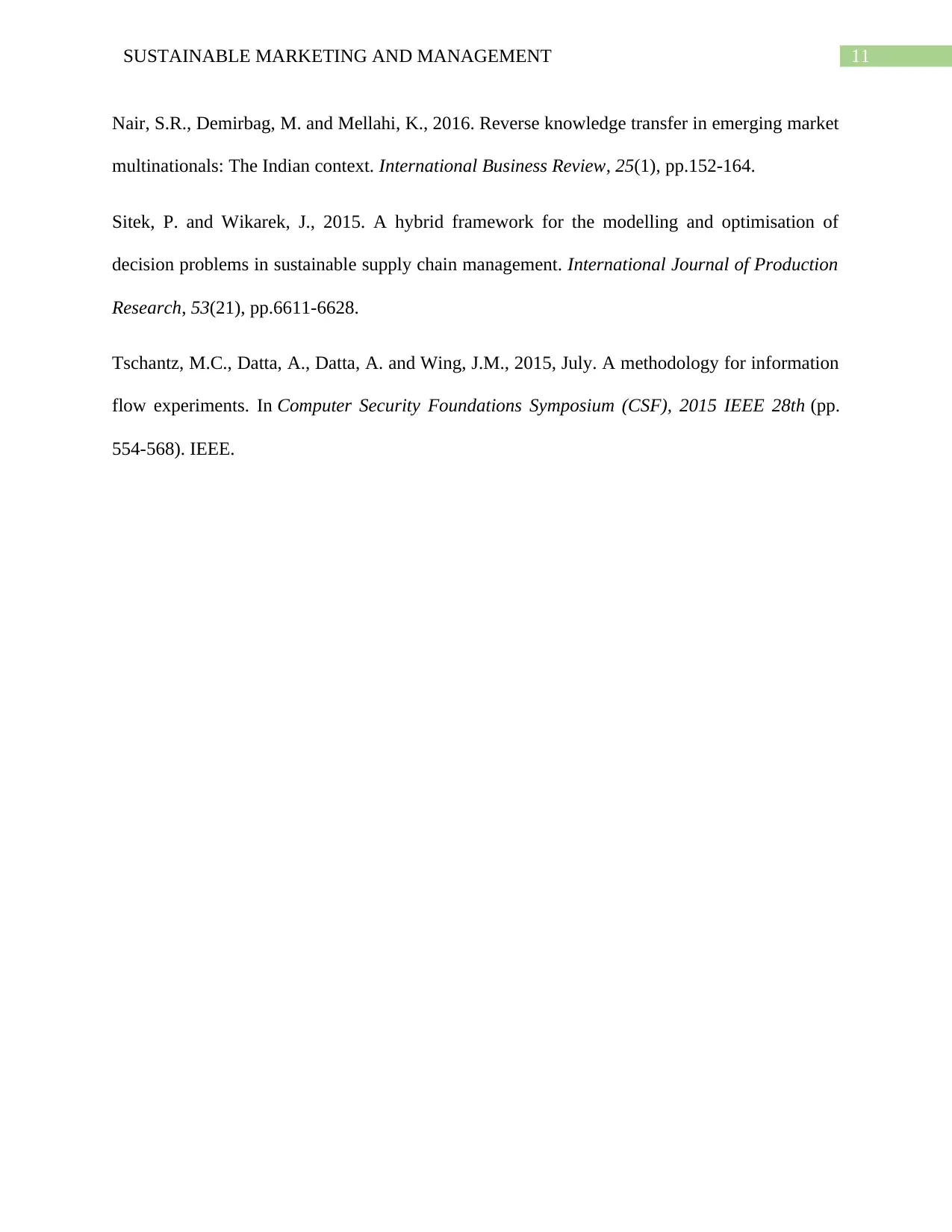
11SUSTAINABLE MARKETING AND MANAGEMENT
Nair, S.R., Demirbag, M. and Mellahi, K., 2016. Reverse knowledge transfer in emerging market
multinationals: The Indian context. International Business Review, 25(1), pp.152-164.
Sitek, P. and Wikarek, J., 2015. A hybrid framework for the modelling and optimisation of
decision problems in sustainable supply chain management. International Journal of Production
Research, 53(21), pp.6611-6628.
Tschantz, M.C., Datta, A., Datta, A. and Wing, J.M., 2015, July. A methodology for information
flow experiments. In Computer Security Foundations Symposium (CSF), 2015 IEEE 28th (pp.
554-568). IEEE.
Nair, S.R., Demirbag, M. and Mellahi, K., 2016. Reverse knowledge transfer in emerging market
multinationals: The Indian context. International Business Review, 25(1), pp.152-164.
Sitek, P. and Wikarek, J., 2015. A hybrid framework for the modelling and optimisation of
decision problems in sustainable supply chain management. International Journal of Production
Research, 53(21), pp.6611-6628.
Tschantz, M.C., Datta, A., Datta, A. and Wing, J.M., 2015, July. A methodology for information
flow experiments. In Computer Security Foundations Symposium (CSF), 2015 IEEE 28th (pp.
554-568). IEEE.
⊘ This is a preview!⊘
Do you want full access?
Subscribe today to unlock all pages.

Trusted by 1+ million students worldwide
1 out of 12
Related Documents
Your All-in-One AI-Powered Toolkit for Academic Success.
+13062052269
info@desklib.com
Available 24*7 on WhatsApp / Email
![[object Object]](/_next/static/media/star-bottom.7253800d.svg)
Unlock your academic potential
Copyright © 2020–2025 A2Z Services. All Rights Reserved. Developed and managed by ZUCOL.





